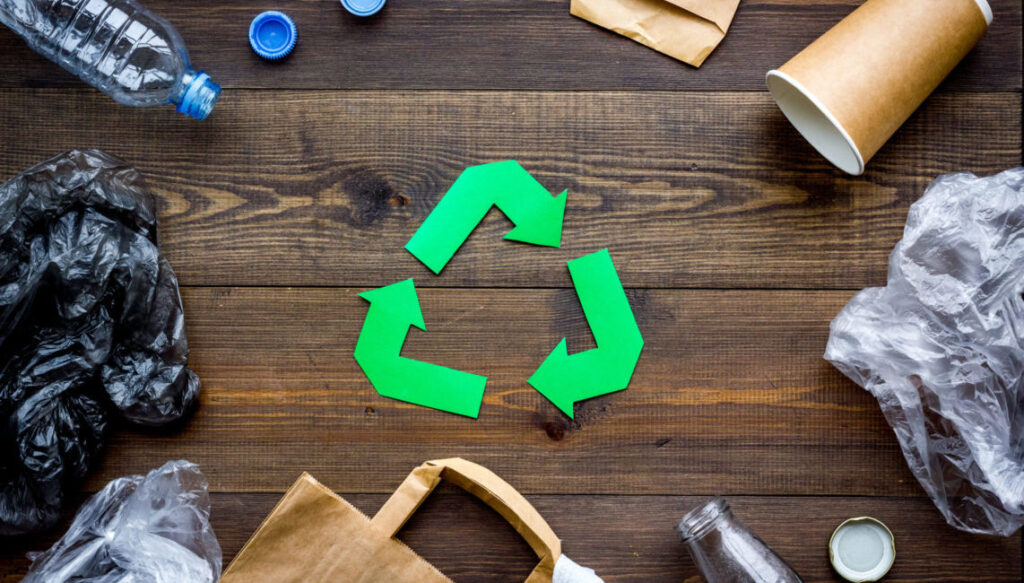Today, most of the trash in the United States can be sorted into two groupings: a blue bin for trash and a green one for recyclables. Sounds pretty straightforward, right? Well, not really.
From used cardboard pizza boxes and plastic bags to single-use coffee cups, we’ve all unknowingly recycled something incorrectly. The recycling industry calls this aspirational recycling or wishful recycling. This is when we think something is recyclable, but it really belongs in the garbage.
When a batch of recyclable goods containing trash makes its way to a recycling facility, it could potentially contaminate the whole batch of otherwise good recyclable material. If a batch is deemed contaminated, waste managers won’t buy it (recycling is an industry, after all), which means all of that otherwise recyclable material goes to the landfill.
Every municipality in the U.S. has different rules and regulations around recycling, depending upon the type of recycling centers available in the area. To simplify matters, we’ve selected seven of the most common culprits that people throw in the wrong bin, explain what to do with them, and tell you how to properly recycle them.

1. Plastic Bags
Single-use plastic bags — the ones you get at grocery and convenience stores with “Thank You” emblazoned on the sides — cannot be thrown in your curbside recycle bin. They’re considered “soft” plastic, meaning that they’re pliable and stretchy. These types of plastics get wrapped around the gears of the sorting machines at recycling operations and prevent them from working properly.
Plastic bags are only one type of soft plastic, though. Other examples include:
- Bread wrappers
- Plastic cereal bags
- Bubble wrap
- Ziploc or sandwich bags
Luckily, these can ALL be recycled — but they have to be sorted separately. There are tons of drop-off locations, including at your local Walmart, Target, Kroger or any other major grocer or retailer. There will be a big box marked “plastic bags” where you can drop off your soft plastics.
2. Pizza Boxes
Pizza boxes are made of corrugated cardboard, so it’s recyclable right? Yes! — and no! The oil and grease that comes off the pizza are actually considered serious contaminates. That oil-soaked section of cardboard is not recyclable and should be thrown in the trash or composted.
The rest, however, is completely recyclable. Simply remove the part with grease (typically the bottom), and recycle the top. By taking three seconds to separate the box, you are potentially saving a whole batch of recycling — so rip it off and carry on!
3. Plastic Containers with Food Scraps
As you might have guessed, leftover food — liquid or solid — is considered a major contaminant. It causes otherwise perfectly fine recycled goods to be tossed into a landfill. For example:
- A milk carton needs to be rinsed out before being placed in the recycle bin.
- Vegetable oil bottles not only need rinsing, but they also need washing to get rid of the excess oil.
- Solid food such as leftover rice or sauce should be rinsed out before recycling the vessel. If it’s still greasy, it should be washed with soap.
Cleaning out your plastic containers gives them a much better chance of being recycled into something else.
4. Disposable Coffee Cups
This is what the waste management industry calls a mixed material item, meaning it’s made up of more than one substance. In the case of coffee cups, the outside may be paper, but the interior is lined with a fine film of polyethylene (plastic) — the stuff that keeps the cup from leaking.
Because of this, the cups themselves cannot be recycled without major effort. Some recycling systems do, though, so you must check with your city to learn if they accept these cups not. Luckily, that cardboard sleeve and plastic lid can definitely be recycled!
5.Styrofoam (Polystyrene Foam)
Polystyrene foam can be recycled, but for the most part, you cannot add it to your curbside bins. Instead, there are specific drop-off locations where you can recycle your polystyrene products. Locations range from grocery stores to environmental and recycling centers that can broker those items on the market.
Yes, it is a bit more work to actively drive to your local recycling center, but those products would otherwise end up in a landfill somewhere.
6. Batteries & Electronics
In the past, batteries could not go in the trash in any fashion. Today, however, most single-use alkaline batteries can safely go into the garbage. The exception is California, where all batteries must be recycled or taken to a hazardous waste disposal facility.
Even so, any rechargeable battery or lead-acid battery cannot be thrown in the garbage, as they pose an environmental safety risk. In fact, it is illegal in some states to improperly dispose of lead-acid batteries.
For safe disposal, take them to your local home improvement store, a consumer tech store or auto parts store. Just call before you do to make sure they accept used batteries.
7. Plastics 3 through 7
This one is a bit complicated. You may have heard of “plastics 1 and 2”? These numbers, which are located inside of the recycling symbol (♻️), refer to a plastic’s resin code. The number indicates to recyclers what type of plastic that item is made from so they know how to properly recycle it.
There are seven types of plastic resins:
- Polyethylene terephthalate (PET): Plastic #1 is the clear, tough material typically used for beverages. It’s one of the most recyclable and in-demand plastics.
- High-density polyethylene (HDPE): Plastic #2 is another highly recyclable and in-demand plastic, as it’s used in jugs, cleaning bottles, shampoo and milk bottles.
- Polyvinyl chloride (PVC): Plastic #3 is harder to recycle due to a lack of demand. However, there are several facilities that accept them. #3’s are typically the soft plastics we talked about earlier.
- Low Density Polyethylene (LDPE): Plastic #4 is also difficult to recycle due to low demand. These are your squeezable bottles used for substances like ketchup and mustard.
- Polypropylene (PP): Plastic #5 can also be difficult to recycle. This includes medicine bottles, yogurt containers, bottle caps and other kinds of squeezable bottles.
- Polystyrene (PS): Plastic #6 includes Styrofoam and other foamed plastics like packing peanuts and clamshell containers. As we mentioned above, these can be difficult to recycle, but it’s still possible.
- Other: Plastic #7 is a catch-all designation for all other plastics not listed above. It can be hard to recycle these, but there are plastic 7 recycling programs in cities.
These numbers determine which plastics you should put in the curbside bin as you check your city’s recycling regulations. If you know your municipal recycling program does not take plastic #5, then do not put it in the bin. It’s that simple. Set aside to be dropped off on a special trip to the recycling center. You also could just throw it in the trash, which leads us to our final point here.

When in Doubt, Throw It Out
Countless recycling associations advocate this phrase. When you throw things in the recycling bin that aren’t meant to be recycled, it can damage recycling equipment and contaminate other recycled goods. Improper wishful recycling defeats the entire point of recycling. Your good intentions amount to nothing when you don’t act responsibly.
That’s why it’s so important to educate yourself and others on what’s actually recyclable in your area and what should go in the trash. You’ll be doing the recycling industry (and the environment) a favor.


